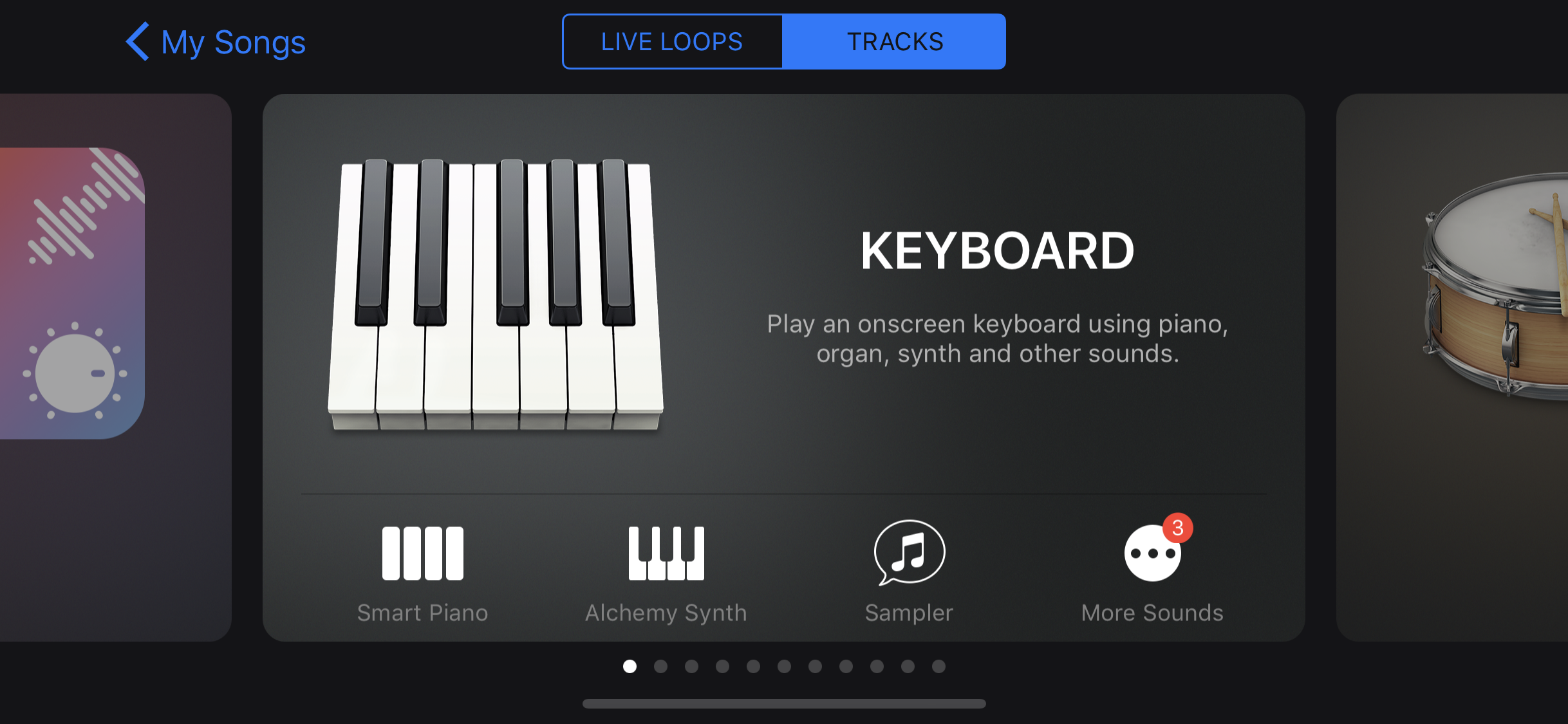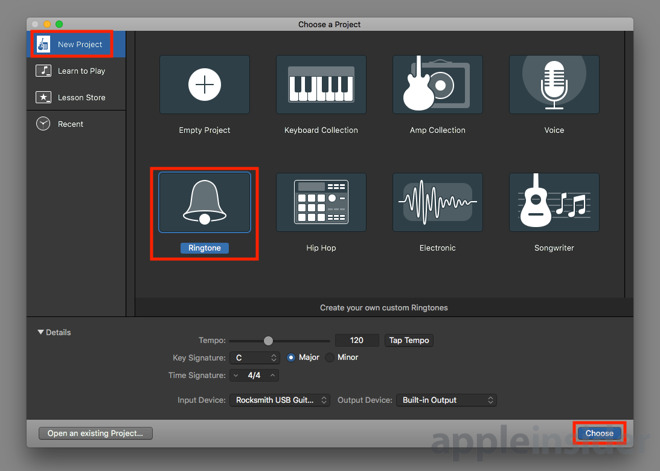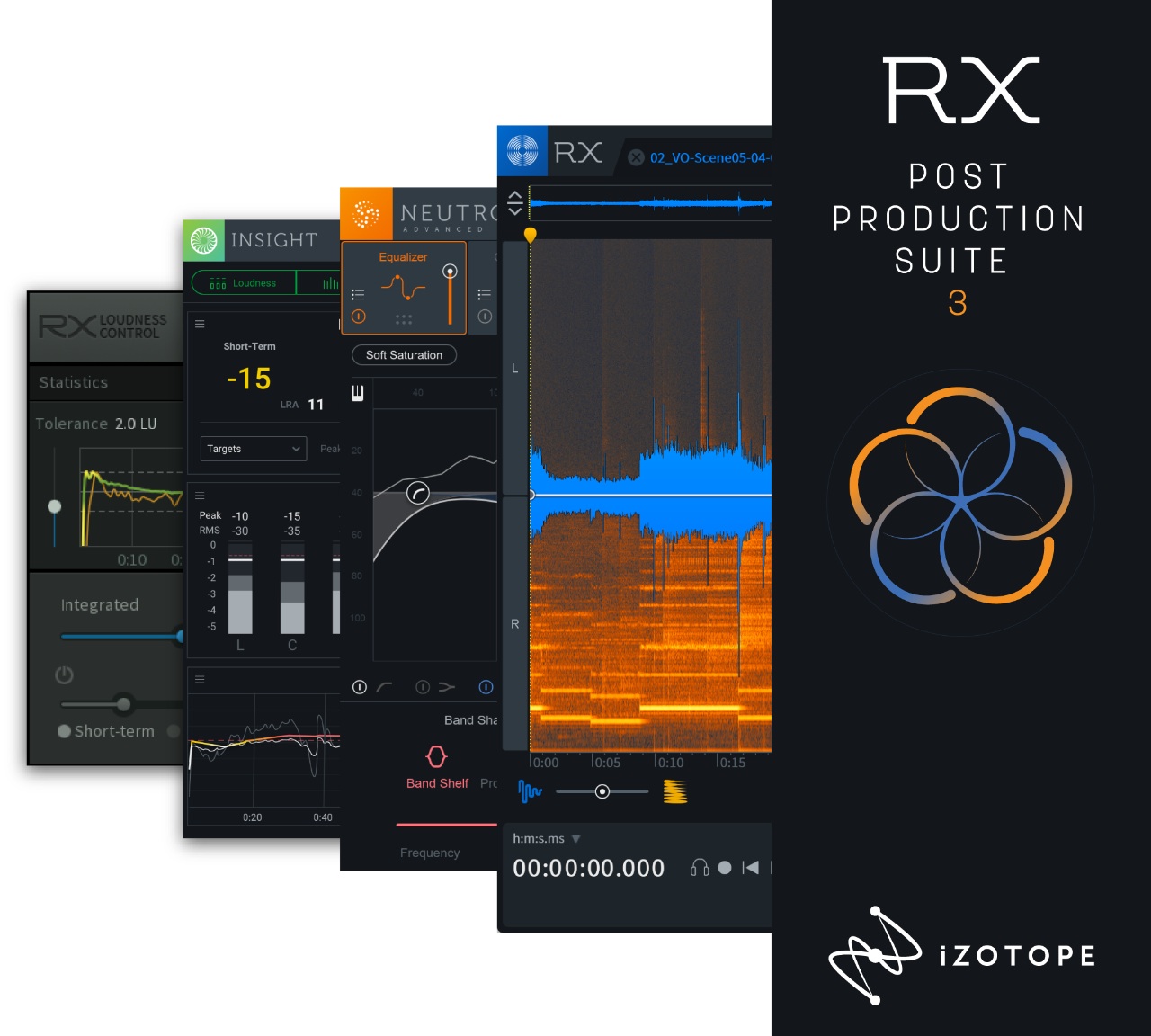Make Ringtone In Garageband 10. 3 On Mac
May 25, 2017 1) Create a new song by selecting the + in the top corner of the GarageBand app and doubling down on the song creation tab. 2) The choice of audio input isn’t necessarily a matter of sink or swim – just for the sake of this tutorial select the Audio Recorder card first. 3) Once the buttons. Creating Ringtones With GarageBand You can use GarageBand on your Mac to create custom ringtones for your iPhone, iPad or iPod touch. You can combine your voice, GarageBand loops, instruments and external files to create almost anything you want. Then you can export them to iTunes and use iTunes to sync the ringtones to your iOS device.
- Make Ringtone In Garageband 10. 3 On Mac Free
- Make Ringtone In Garageband 10. 3 On Mac Computer
- Make Ringtone In Garageband 10. 3 On Mac Pro
- Make Ringtone In Garageband 10. 3 On Mac Download
- Make Ringtone In Garageband 10. 3 On Mac Computer
- With GarageBand on your iOS device, you can make ringtones on your iOS device and instantly activate the ringtones on your iPhone iPad or iPod. Create ringtones using GarageBand on iPad. In this demo, we will use GarageBand on iPad to show you the steps. There are mainly two steps to make a ringtone for iPhone iPad iPod using GarageBand.
- Here you can download garageband online for windows 10 8 and 7. How to use garageband on mac. Check out macbook pro imac pro macbook air macbook imac and more. Garageband is a line of digital audio workstations for macos and ios devices that allows users to create music or podcasts. Garageband tutorial for beginners 5 things you need to know.
- Apple has introduced a simple and free way to create and sync your own custom ringtones to the iPhone using GarageBand (i.e., Mac only). The first thing you'll need to do, if you haven't already.
May 25, 2017 If it happens to be stored on your Mac or any third-party iOS app, just transfer the file into the iCloud Drive folder or iCloud Drive app respectively. 1) Create a new song by selecting the + in the top corner of the GarageBand app and doubling down on the song creation tab.
Create a ringtone
- Select a track to use as the source. You cannot use an Apple Music item, or anything that is in the cloud.
- On the Get Info > Options tab set start and stop times no more than 40 seconds apart, or 30 seconds for text tones.
- Under Edit (Win) or iTunes (Mac) > Preferences > General tab > Import Settings choose AAC Encoder > High Quality 128k. **
- Use File > Convert > Create AAC version.
- Reset the start and stop times on the original track.
- Right-click on the new copy and click Show in Windows Explorer or Finder.
- Delete the new entry from the library without sending to the recycle bin/trash. *
- Change the file extension from .m4a to .m4r. (You may need to adjust folder options to see the extensions.)
- If running iTunes 12.7 or later you should move the file into <Media Folder>Tones.
* If you omit this step on a Mac iTunes/Music will remain connected to the renamed file as if it was a regular music track, and it may then ignore any attempt to manually add it to your device.

** In Music for Catalina the Import Settings option is found under Music > Preferences > Files.
Add ringtone to device, iTunes 12.6.5 or earlier
- Move the file into the Automatically Add to iTunes folder inside your media folder, it will be added to the Tones section of the library and move into the Tones folder inside the media folder.
- If you don't see Tones in the drop down media selection menu click Edit Menu at the bottom and add it.
- Connect the device, select its icon next to the media selection menu, then the device's Tones tab, and set the sync options.
- Sync the device.
Add ringtone to device, iTunes 12.7 or later
- Connect device to computer.
- Enable the sidebar in iTunes if hidden.
- Drag & drop * or copy & paste the ringtone from Windows Explorer or Finder onto the device where it appears in the iTunes sidebar (drop) or to the Music or Tones sections of the device when expanded (paste). Which method works seems to vary.
- From iTunes 12.7 there is no longer a dedicated Tones section within the iTunes library.
- Tones created with earlier versions of iTunes or purchased on and transferred from a device will normally be found in the Tones folder inside the media folder. Alternatively there may be a Ringtones folder in the media folder or the main iTunes folder.
- Tones shared as a ringtone to iTunes with GarageBand for Mac or Logic may be in a folder called Import inside the media folder.
* Some Windows users have noted that this method fails if they are running iTunes as the administrator. In some cases it may be necessary to exit the BTTray.exe utility, if present, before iTunes can be launched in non-admin mode. Mac users may find that omitting step 7 from the steps in Create a ringtone means that iTunes/Music is still attached to the ringtone file as an entry in the music library, if so it will be blocked from copying to a device.
Add ringtone to device, macOS 10.5 Catalina
- Connect your device to your Mac, and open the general tab for it in Finder.
- Drag and drop your .m4r file from another open Finder window to the General tab for your device.
Issues after updating iOS
Some users have reported that existing tones will no longer play after an iOS update, or that they cannot add new tones. If this happens you may need to remove all existing tones from the device, reboot, and then reimport your ringtones.
Remove tones using iTunes 12.7 or later

- Connect your iOS device to iTunes.
- Select it using the icon that appears next to the media selection drop down tool.
- Change to manual management if necessary on the Summary tab.
- Select and delete unwanted tones from On My Device > Tones.
- Switch back to syncing with selected content if desired.
N.b. It should be possible to switch a synced device to manual management and back to syncing with selected content without existing content being removed or replaced, despite the warnings iTunes may give, as long as you are using the library previously used to sync content to the device.
Removing hidden tones
Some users have found that custom tones that are on their device don't show in iTunes so cannot be removed using the method above. In such cases you could try iFunBox * or a similar third party utility to make changes in the raw file system of the device. In iFunBox try My Device > Toolbox > User File System (Win) or Raw File System (Mac) then iTunes_Control > Ringtones to locate the relevant folder. Any custom tones on your device show up there with random 4 letter file names and a .m4r extension. Deleting all the .m4r files in this folder should clear all custom tones from the list on the device, and you can then add back what you want using iTunes. You may also need to delete the .plist file found in this folder. Copy off the .m4r files first if you don't have original copies of them on your computer.
* Windows 10 users may need to uninstall iTunes if it was installed from the Microsoft Store and then reinstall using the more traditional iTunes64setup.exe available at https://www.apple.com/itunes/download/win64 to work with iFunBox.
N.b. making incorrect changes in the raw file system has the potential to make your device unstable. Backup before you begin and ideally Archive the backup in case there is a need to return to it.
The instrument combines sample-based spectral manipulation with a large variety of oscillators, five morphable and five envelopes that can be easily mapped by dragging and dropping the target icon onto a parameter.Likewise, eight macro controls can be configured just as easy to give immediate access to single or multiple parameters from a single knob. While other plugins have similar spectral technology, iZotope seems to have a way of making the most complex processes intuitive and user-friendly. The Shred effect will appeal to the glitch-minded.Iris 2 is one of the few virtual instruments offered by iZotope, and it takes full advantage of the companies years of R&D in implementing FFT-based algorithms. The Spectral display has just a few controls for looping, crossfade, offset starting point, and delay onset. 
Related support documents
Make Ringtone In Garageband 10. 3 On Mac Free
By Malcolm Owen
Tuesday, April 10, 2018, 11:44 am PT (02:44 pm ET)
Creating a ringtone from the iOS device itself is easier in some respects compared to doing the same thing via GarageBand for Mac. While the music production or recording creation element is slightly different, due to it being iOS-based instead of macOS along with different recording options, the overall process is quite similar to the Mac version.
The main difference is exporting the ringtone and implementing it on the iPhone or iPad. Where the Mac requires users to find the file and import it into iTunes to apply it to their devices, exporting as a ringtone is more direct when performing the procedure on the smartphone or tablet itself.
Creating the Tone
Open GarageBand. If you have an existing project available, skip down to the Sharing the Tone section below.
Start a new project by tapping the plus symbol in the top-right corner.
While this guide isn't going to delve into GarageBand production, it is suggested to the reader to experiment with all of the options available, depending on what they want their ringtone to sound like by the end.
For example, you could use the virtual session drummers to create a basic beat, then lay down extra tracks using the built-in virtual instruments. This can also be used to record singing using the built-in microphone or the playing of real instruments.
A quick way to create a track is to go into the Live Loops section, selecting one of the example sample grids, and then record a session using the included samples.
Once created, tap My Songs in the top left to save the project. Give the new project a long press and select Rename, give the song a title, and tap Done.
Sharing the Tone
Long-press the new track or the existing project, and select the pop-up Share option. The new panel will offer three options, to export as a song, a ringtone, or as a project. Select Ringtone.
If you wish to use a different name for the ringtone instead of the song title, change the name by tapping it, otherwise just tap Export. This will bring up an extra notification advising it was successful, and while OK will end the process, Use sound as.. will allow for it to be set as a ringtone straight away.
Selecting Use sound as.. will bring up three more options, namely to set it as the Standard Ringtone, Standard Text Tone, or to Assign to a contact. Selecting either of the first two will change the default assigned tone to the new one, and will end the process.
If you opt for Assign to contact, the full list of contacts stored on the iPhone or iPad will be shown onscreen. Scroll through and select the contact you want to use. Lastly, select between Assign as Text Tone and Assign as Ringtone to complete the procedure.
Regardless of whether the tone is assigned or not, it will be immediately available to use in the main tone settings as an extra tone option.
To make it the default tone after exporting, go to the Settings app followed by Sounds then Ringtone. The custom apps will be at the top of the list, and can be tapped to set as the default tone.
Deleting the Tone
Make Ringtone In Garageband 10. 3 On Mac Computer
Custom ringtones created in GarageBand iOS and exported to the same device are not accessible within iTunes on a Mac, for unknown reasons. It is possible to remove the tones, but from within GarageBand itself.
Long-press any project and select the Share option, followed by Ringtone. On the screen for entering a new name, select Your Ringtones below the textbox.
This will list all custom-made ringtones created on the iOS device. Tap Edit to bring up the deletion options, tap the red circle next to the tone you wish to remove, then the new Delete button to confirm its removal.
Once finished, click Done, and exit the export menus.
Make Ringtone In Garageband 10. 3 On Mac Pro
Make Ringtone In Garageband 10. 3 On Mac Download
Encore
Just like the Mac version, GarageBand for iOS ringtones are limited to only 40 seconds in length as a maximum. Rather than warn of this during the export, GarageBand automatically clips the tone to the first 40 seconds, eliminating the rest of the track.
Make Ringtone In Garageband 10. 3 On Mac Computer
If you have a composition and want to use only part of the song from the middle or the end, for example, duplicate the project on the Recent Projects page by a long-press followed by Duplicate. Enter this duplicated project and trim the track down to 40 seconds or less, before sharing again.
Also, it is advised that readers do not import music tracks they do not have permission or the rights to use for their own ringtones, for copyright-related legal reasons. If you want to use copyrighted music, a sound effect, or a fictional character's catchphrase, it is recommended to look at the tones available in the iTunes store.